2020年最新中考英语语法考点汇总(最全版)
- 格式:doc
- 大小:298.50 KB
- 文档页数:24
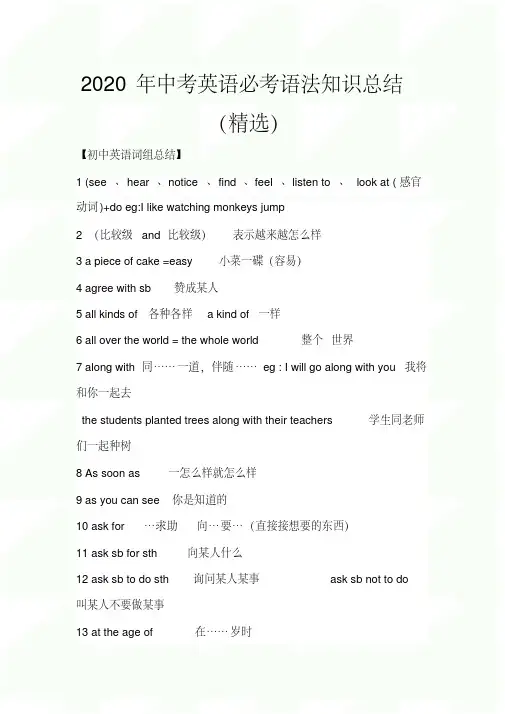
2020年中考英语必考语法知识总结(精选)【初中英语词组总结】1 (see 、hear 、notice 、find 、feel 、listen to 、look at (感官动词)+do eg:I like watching monkeys jump2 (比较级and 比较级)表示越来越怎么样3 a piece of cake =easy 小菜一碟(容易)4 agree with sb 赞成某人5 all kinds of 各种各样 a kind of 一样6 all over the world = the whole world 整个世界7 along with同……一道,伴随…… eg : I will go along with you我将和你一起去the students planted trees along with their teachers 学生同老师们一起种树8 As soon as 一怎么样就怎么样9 as you can see 你是知道的10 ask for ……求助向…要…(直接接想要的东西)11 ask sb for sth 向某人什么12 ask sb to do sth 询问某人某事ask sb not to do叫某人不要做某事13 at the age of 在……岁时14 at the beginning of …… ……的起初;……的开始15 at the end of +地点/+时间最后;尽头;末尾16 at this time of year 在每年的这个时候17 be /feel confident of sth /that clause +从句感觉/对什么有信心,自信18 be + doing 表:1 现在进行时 2 将来时19 be able to (+ v 原) = can (+ v 原)能够…… 21 be afraid to do (of sth 恐惧,害怕…… 22 be allowed to do 被允许做什么23 be angry with sb 生某人的气24 be angry with(at) sb for doing sth 为什么而生某人的气25 be as…原级…as 和什么一样eg : She is as tall as me 她和我一样高26 be ashamed to27 be away from 远离28 be away from 从……离开29 be bad for 对什么有害30 be born 出生于31 be busy doing sth 忙于做什么事be busy with sth忙于…… 32 be careful 当心;小心和什么不一样33 be different from…… 34 be famous for 以……著名35 be friendly to sb 对某人友好36 be from = come from 来自37 be full of 装满……的be filled with 充满eg: the glass is full of water the glass is filled with water38 be glad+to+do/从句39 be going to + v(原)将来时40 be good at(+doing) = do well in 在某方面善长, 善于…… 41 be good for 对什么有好处42 be happy to do 很高兴做某事43 be helpful to sb 对某人有好处44 be in good health 身体健康45 be in trouble 处于困难中46 be interested in 对某方面感兴趣47 be late for = come late to 迟到eg: Be late for class 上课迟到48 be like 像…… eg : I'm like my mother49 be mad at 生某人的气50 be made from 由……制成(制成以后看不见原材料)51 be made of 由……制成(制成以后还看得见原材料)52 be not sure 表不确定53 be on a visit to 参观54 be popular with sb 受某人欢迎55 be quiet 安静56 be short for 表**的缩写eg: 陶is short for 陶俊杰57 be sick in bed 生病在床58 be sorry to do sth be sorry for sb eg : I am sorry for you59 be sorry to hear that60 be sorry to trouble sb61 be strict in doing sth 严于做某事62 be strict with sb 对某人要求严格63 be strict with sb in sth 某方面对某人严格64 be supposed to do 被要求干什么65 be sure 表确定66 be sure of doing sth 对做某事有信心67 be sure of sth 对做某事有信心68 be sure that sth 对做某事有信心69 be sure to do sth一定会做某事We are sure to learn English well 我们一定能学好英语70 be terrified of + 名/动doing 害怕…… 71 be terrified to do sth 害怕做某事72 be the same as … 和什么一样73 be used to doing sth 习惯做某事My father is used to getting up early 我爸爸习惯早74 be worth doing 值得做什么75 be(feel) afraid to do sth 害怕做某事be afraid of sth 害怕某物be afraid that 丛句76 because+句子because of +短语eg : He was late because he had a headache He was late because of his headache77 begin to do = start to do 开始做某事以什么开始什么start…with…=begin…with… 78 between…and… 两者之间79 borrow sth from sb 向……借…… lend sth to sb ( lend sb sth 借给……什么东西80 both = the same(as) = not different(from) 表相同81 bother 打扰bother sb to do stheg : I'm sorry to bother you ,but can you tell me to way to the station 我十分道歉打扰你,但是你能告诉我怎么去车站82 by the end of 到……为止83 call sb sth eg : We call him old wang85 catch up with sb 赶上某人86 chat with sb 和某人闲谈take sb to + 地点带某人去某地87 come in 进88 come over to 过来89 come up with 提出eg: Can you come up with a good idea 你能想出一个好办法吗?90 communicate with sb 和某人交流91 consider + doing 考虑做什么eg : Why not consider going to lu zhou 为什么不考虑去泸州?92 dance to 随着……跳舞93 decide to do sth 决定做某事94 do a survey of 做某方面的调查95 do better in 在……方面做得更好96 do wrong 做错97 Don't forget to do sth 不要忘了做某事98 Don't mind +doing /从句/名词不要介意…… 99 each +名(单)每一个…eg : Each student has many books 每一个学生都有一些书100 end up +doing101 enjoy +doing喜欢102 escape from 从……逃跑103 expect to do sth 期待做某事104 fall down 摔下来fall off 从哪摔下来105 fall in love with sb /sth 爱上什么106 far from 离某地远107 find +it +adj +to do 发现做某事怎么样108 find sb/sth +adj 发现什么怎么样eg : I find the book interesting 109 finish 完成+doing(名词)110 fit to sb = be fit for sb 适合某人111 forget to do 没有做而忘了forget doing 做了而又忘了112 from…to… 从某某到某某eg: From me for her113 get /have sth down 做完,被(别人)做…eg: I have my hair cut 我理了发(头发被剪了)Tom got his bad tooth pulled out 汤母把他的坏牙拔掉了(被牙医拔掉了)114 get a part-time job= find a part-time job115 get along well with sb = get on well with sb 与某人相处得好116 get along with sb = get on with sb 与某人相处117 get ready for = be ready for为什么而准备118 get sb in to trouble 给某人带来麻烦120 get…from… 从某处得到某物121 give a talk 做报告122 give sth to sb give sb sth 给某人某物123 go fish 钓鱼go swimming 游泳124 go on to do 去做下一件事go on doing 继续做这件事125 go out away from远离go out of 从….离开126 go to school 上学(用于专业的)go to the school 去学校(不一定是上学)127 good way to 好方法128 hate to do 讨厌没做过的事hate doing 讨厌做过的事129 have a party for sb 举办谁的晚会130 have a talk 听报告谈一谈131 have been doing 现在完成进行时132 have been to …( 地方)……去过某过地方have gone to …(地方)去了某地还没回来133 have fun +doing 玩得高兴134 have sth to do 有什么事要做135 have to do sth 必须做某事136 have trouble (problem) (in) doing sth 做什么事情有麻烦137 have…time +doing138 have…(时间)…off 放……假139 hear sb +do/doing听见某人做某事/正在做某事140 help a lot 很大用处141 help sb with sth \one's sth 帮助某人某事(某方面)help sb (to) do sth 帮助某人做某事142 hope to do sth 希望做某事143 How about(+doing) = What about(+doing)144 how do you like = what do you think of 你对什么的看法145 if : 是否=wethereg: I don't know if (wether) I should go to the party 我不知道我是否应该去参加晚会He don't know if (wether) we will arrive on timetomorrow morning 他不知道我们明天早上是否能准时到达146 if :如果,假如(全部接一般时态)+条件语态从句eg: I'll go to LuZhou if it does't rain 假如明天不下雨,我就去泸州If they change the plan they will let me know 假如他们要改变计划,他们会让我知道的I'll go to England ,if I have enough money next year 如果我明年由足够的钱,我就要去英国147 in one's opinion = sb think 某人认为148 in some ways 在某些方面149 in the end = finally(adv) 最后什么在什么的北方(north 北150 in the north of… sowth 南west 西east 东)151 in the sun 在太阳下152 increase 增加eg : They've increased the prece of petrol by 3% 他们把石油价增加了3%153 instead of +(名)代替eg: I'd like an apple instead of a pear 我想要苹果,而不要梨子154 introduce sb to sb 介绍某人给某人introduce oneself自我介绍155 invite sb to do sth 邀请某人做某事156 It takes sb sometime to do sth 做某人花掉某人多少时间eg : It took me 5 minutes to do my homework It takes me half an hour to cook157 It's +adj +for sb to do sth 对某人来说做某事怎么样158 It's +adj +to do 做某事怎么样159 It's +adj for sb 对于某人来说怎么样It's +adj of sb 对某人来说太怎么样160 It's +adj(for sb) to do(对某人来说)做某事怎么样It's +adj of sb to do sth 对某人来说做某事太怎么样eg : It's nice of you to help me with my English161 It's a good idea for sb to do sth 对…… 来说是个好主意162 It's important to sb 对某人来说很重要eg: It's important to me163 It's time to do sth It's time for sth 到了该去做某事的时间eg : It's time to have class It's time for class 该去上课了164 join = take part in 参加165 just now 刚才166 keep +sb /sth +adj /介词短语让什么保持什么样?167 keep out 不让…… 进入168 keep sb adj 让……保持…… keep healthy 保持健康169 key to +名词表示:某物的钥匙或某题的答案170 key to… anser to … key 可以是答题或钥匙取笑…… 171 laugh at… 172 learn by oneslfe 自学173 learn from sb 向某人学习174 learn to do sth 学做某事175 let sb do sth 让某人做某事176 Let sb down 让某人失望eg :We shouldn't let our farents down 我们不应该让我们的父母失望177 live from :离某地远178 live in +大地方/at +小地方居住在某地179 look after = take care of 照顾照看180 lose one's way 谁迷路181 make a decision to do sth 决定做某事182 make friends with sb 和谁成为朋友eg : I want to make friends with you183 make it early 把时间定的早一点184 make on exhibition of oneself 让某人出洋相185 make sb /n +n 使什么成为什么eg : I made her my step moller I made you my wife186 make sb /sth +adj 使某人(某物)怎么样eg : You must made your bed clean187 make sb /sth adj 使某人/某物怎么样188 make sb do sth 让某人做某事189 make up be made up of (被动语态)由……组成190 make…difference to… 191 mind sb to do mind one's doing 介意……做什么192 most +名most of +代193 much too +形容词194 must be 一定195 need +名词196 need sb do sth 需要某人做某事197 need to do (实义动词)need do (情态动词)198 no /neithr of hate to do no /neithr of hate doing199 no +名词200 not anymore = no more 再也不…… eg: He didn't cry any more201 not… (形、副)at all eg: He's not tall at all she doesn't junp far at all202 not…at all 一点都不203 not…either 表否定,也不eg : I don't japanse either I don't have sister, either 我也没有姐姐204 not…until 直到……才…… 205 offer / provide sb with sth 给某人提供206 offer sb sth ( offer sth to sb 提供什么东西给某人eg : I offer you water (I offer water to you 我给你提供水207 on one's way to… 在谁去那的路上208 on the one hand 一方面on the other hand 另一方面209 on the phone = over the phone 用电话交谈210 on time 准时in time 及时211 one day =some day =someday 一天,有一天212 one of +可数名词的复数形式213 one to another 一个到另一个214 over and over agin 一遍又一遍的eg : He cleaned the floor over and over agin215 part-time job 兼职工作fall-time job 全职工作216 pay for… 付……钱pay the bill 开钱,付钱217 please +do218 please help yourself219 pleased with sb220 pool into = pore into221 practice +doing 练习做某事222 prefer sth to sth 相对……更喜欢…… eg : I prefer physics to chemisty 在物理和化学中,我更喜欢物理prefer sb not to do sth 更愿意… eg: I prefer her not to come 我不喜欢她不来223 pretend to do sth 装着去做什么pretend that 从句eg : The two cheats pretended to be working very hard 这两个骗子装着努力工作224 rather…than 宁可……也不…… eg : I would rather be a doctor than a teacher 我愿肯当医生,也不当老师225 regard…as 把……当作…… I regard you as my friend我把你当作我的朋友226 remid sb about sth 提醒某人什么事remid sb to do sth 提醒某人做某事eg : he remids me about cooking (he remids me to cook他提醒我做饭227 remid sb of sth 使某人想起什么the words that (which) the teacher talke to remind me of my mother 228 return sth to sb 还什么东西给某人229 say to oneself 对自己说230 say to sb 对某人说231 sb spend somemoney on sth 花了多少钱在某事上232 sb spend sometime with sb 花了多少时间陪谁233 sb spend sometime(in) doing sth 花了多少时间做某事234 sb with sb +is sb and sb +are235 see sb do 看见某人做过某事see sb doing 看见某人正在做某事236 seem to do/be +adj 显得怎么样eg : You seem to be tired You seem to be happy237 send +sb sth 送给某人某物238 send…to…把什么寄到哪里去?239 shock 使……震惊eg : Oh , It's only you ! You give me a shock 啊,是你呀!吓我一跳240 show sb sth 向某人展示某物241 show sb sth = show sth to sb 拿什么东西给某人看242 show sth to sb 向某人展示某物243 some…others… 一些……另一些…… 244 start…with… 从……开始begin…with… 从……开始245 stay away from 远离…… eg : We're told to stay away from the animals whe visiting the zoo 当我们参观zoo 时,我们要远离动物246 stop doing 停下正在做的事247 stop sb from doing sth 阻止某人做某事248 stop sb(from) doing 阻止某人做某事249 stop to do 停下正在做的事去做下一件事250 such +名这样,这种251 suit sb 适合某人252 surprise sb 使某人惊奇to one's surprise 令某人惊奇253 take classes 上课254 take sb to 把某人带去eg : I take you to the hospital255 take walks = take a walk =go for a walk 散步256 ①talk to 对谁说②talk with 和谁说③talk of 谈到④talk about 谈论关于…… 257 talk with sb 和某人说话258 teach sb sth 教某人做某事259 tell sb do sth 告诉某人做某事261 tell sb sth 告诉某人某事tell sb that 丛句tell sb not to do sth262 tell sb 〔not〕to do sth 告诉某人做什么263 tell…from…区别264 thank you for +doing265 the same +名词(doing)+as…… 266 the same…(名)…as as…(adj adv)…as 相同267 the way to do sth =the way of doing st做某方面的方法the way to +地方去哪的路e g :Do you know the way to learn English Do you know the way of learning English268 the way to…(地点)到哪的把什么翻译成什么eg : Trasalte 270 transalte ……into…… English into chinese271 travel with sb和某人去旅游272 try one's best to do sth尽某人最大的努力去做某事eg: I will try my best to learn English well273 try to do sth 想干什么,但没成功try doing sth 想干什么,已经做过了274 try…试衣服have a try 试一下275 turn down 开小←→ turn up 开大276 turn off 关上←→ turn on 打开open 拆开277 upside down 倒着278 visit to…参观某个地方279 wait for sb 等某人【比较since和for 】Since 用来说明动作起始时间,for用来说明动作延续时间长度。
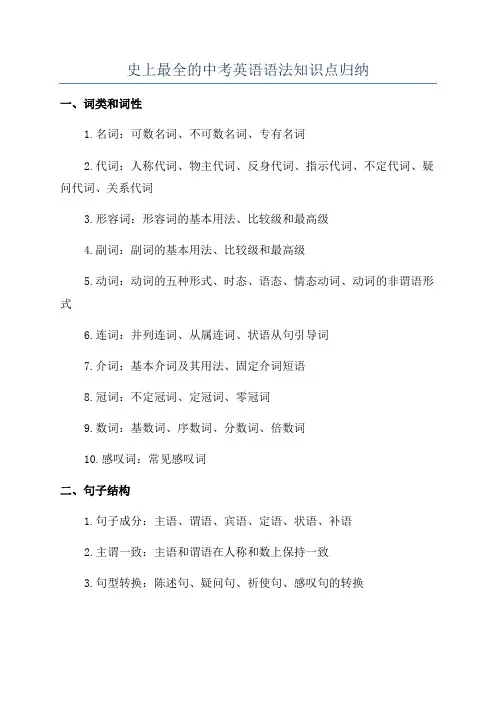
史上最全的中考英语语法知识点归纳一、词类和词性1.名词:可数名词、不可数名词、专有名词2.代词:人称代词、物主代词、反身代词、指示代词、不定代词、疑问代词、关系代词3.形容词:形容词的基本用法、比较级和最高级4.副词:副词的基本用法、比较级和最高级5.动词:动词的五种形式、时态、语态、情态动词、动词的非谓语形式6.连词:并列连词、从属连词、状语从句引导词7.介词:基本介词及其用法、固定介词短语8.冠词:不定冠词、定冠词、零冠词9.数词:基数词、序数词、分数词、倍数词10.感叹词:常见感叹词二、句子结构1.句子成分:主语、谓语、宾语、定语、状语、补语2.主谓一致:主语和谓语在人称和数上保持一致3.句型转换:陈述句、疑问句、祈使句、感叹句的转换4.句子的简单句、并列句、复合句、复合句类型(定语从句、状语从句、宾语从句)三、时态和语态1.一般现在时2.一般过去时3.现在进行时4.过去进行时5.一般将来时6.一般过去将来时7.现在完成时8.过去完成时9.现在完成进行时10.一般过去完成进行时11.被动语态四、非谓语动词1.不定式2.动名词3.动词-ing形式五、虚拟语气1.与事实相反的虚拟语气:与现在事实相反的虚拟语气、与过去事实相反的虚拟语气2.与将来事实相反的虚拟语气3.与现在条件相反的虚拟语气4.与过去条件相反的虚拟语气六、定语从句1.关系代词引导的定语从句2.关系副词引导的定语从句3.定语从句的嵌套七、状语从句1.时间状语从句2.地点状语从句3.方式状语从句4.原因状语从句5.条件状语从句6.比较状语从句7.目的状语从句8.结果状语从句八、宾语从句1.宾语从句的引导词2.宾语从句的位置九、名词性从句1.主语从句2.宾语从句3.表语从句十、情态动词1.can和could2.may和might3.will和would4.shall和should5.must和have to6.need和dare以上是中考英语语法知识点的简要归纳,更详细的内容需要根据课本和学习资料进行学习和理解。
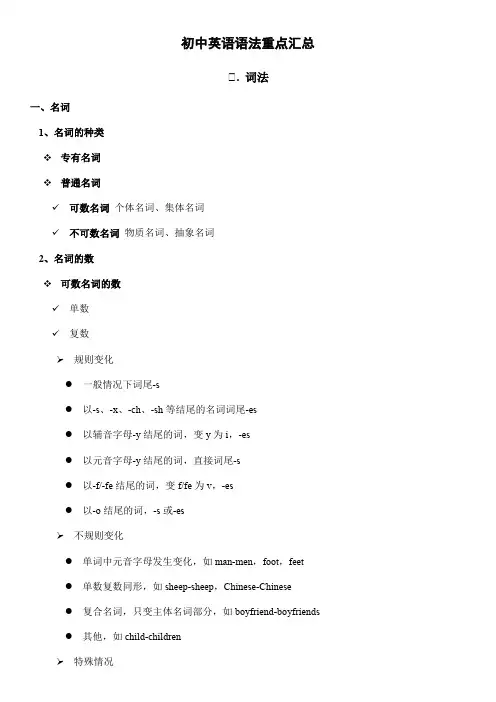
初中英语语法重点汇总Ⅰ. 词法一、名词1、名词的种类❖专有名词❖普通名词✓可数名词个体名词、集体名词✓不可数名词物质名词、抽象名词2、名词的数❖可数名词的数✓单数✓复数➢规则变化●一般情况下词尾-s●以-s、-x、-ch、-sh等结尾的名词词尾-es●以辅音字母-y结尾的词,变y为i,-es●以元音字母-y结尾的词,直接词尾-s●以-f/-fe结尾的词,变f/fe为v,-es●以-o结尾的词,-s或-es➢不规则变化●单词中元音字母发生变化,如man-men,foot,feet●单数复数同形,如sheep-sheep,Chinese-Chinese●复合名词,只变主体名词部分,如boyfriend-boyfriends●其他,如child-children➢特殊情况●只用复数的名词●以-s结尾但并不是复数的名词●集体名词既可以复数,也可以单数●其他❖不可数名词的数✓不可数名词没有复数形式✓有些不可数名词表示具体事物时可数,但意义不同,如chicken,paper3、名词的计量❖可数名词的计量❖不可数名词的计量4、名词所有格❖-’s所有格❖of+名词所有格❖of+-’s 双重所有格❖被名词所有格修饰的名词的省略5、名词在句子中的作用作主语作表语作宾语作宾语补足语作定语作状语作同位语作称呼语二、代词1、人称代词2、物主代词3、反身代词4、相互代词有each other和one another等5、指示代词❖单数:this,that❖复数:these,those6、不定代词❖some和any❖many和much❖both和all❖neither和none❖either、each和every❖another、other(s)和the other(s)✓for another two weeks = for two more weeks ✓some...others...✓one...the other...✓the others = the other +复数❖(a) few和(a) little❖one(s)❖复合不定代词:some-,any-,no-,every-❖复数:these,those7、疑问代词❖指人✓主格:who✓宾格:whom✓所有格:whose❖指物what❖指人或物which8、连接代词who,whom,whose,what,which,whoever,whatever,whichever 9、关系代词who,whom,whose,what,which三、数词1、常见表达法❖日期与时刻✓日期某月某年、某月某日、“月日,年”或“日月,年”✓时刻直接读数表示、用past或to表示❖年龄和年代✓年龄基数词✓年代in the+带有整十的年份的复数或-’s形式❖货币符号+基数词❖编号名词+基数词、the+序数词+名词❖ 小数分数百分数✓ 小数 如three point nine o/zero seven (3.907) ✓ 分数➢ 分子用基数词,分母用序数词,分子大于1时分母序数词后加-s ,如:one third (31),two fifths (52)➢ 分子是2时,常用half ;分子是4时,常用quarter➢ 带分数用“基数词+and+分数”,如:one and two fifths (521)❖ 倍数✓ 倍数+比较级+ than ✓ 倍数+ as +原级+ as ✓ 倍数+ as many/much...+ as...✓ 倍数+ the size/weight/height/length/age...+of... ❖ 约数✓ 大约 about ,nearly ,almost ,some ,around 等 ✓ 超过 over 或more than ✓ 少于 less than ✓ 左右 or so ❖ 算式“+” 用plus 或and ;“-”用minus ;“×”用times 或multiplied by ;“÷”用divided by 2、数词的句法功能❖ 作主语 Twenty of them are from Chonqing. ❖ 作宾语 I like the third best. ❖ 作表语 He is twelve.❖ 作定语 Tom is the tallest of the three boys. ❖ 作状语 Where did you first meet him?❖作同位语We two will help you.3、数词的构成和用法❖基数词✓100以内基数词✓100以上基数词❖序数词✓1~3,4~19✓20~90整十位数✓21以上✓一百、一千、一百万四、介词1、介词的分类简单介词、合成介词、双重介词、短语介词2、介词的位置常规位置、其他位置3、介词短语❖构成介+名,介+代,介+数,介+动名,介+疑问词+不定式,介+从句❖作用作定语、作状语、作表语、作宾语补足语4、介词固定搭配介词与名词、介词与动词、介词与形容词、介词与副词、介词与过去分词5、常见介词用法❖表示时间✓at,in,on✓since,for✓after,in✓by,until/til✓before,after✓from✓during❖表示地点、方位✓at,in,on,to✓on,over,above,under,below✓beside,by,near,nearby,next to,around ✓inside,outside✓into,onto,out of,off✓across,through,past,over,along,down ❖表示方式手段工具✓in,on,by✓in,by,with❖其他✓on,about✓except,except for,besides ✓between,among✓of✓like ✓with✓without ✓for✓as✓against五、冠词1、冠词的用法❖定冠词✓特指的✓谈话双方都知道的✓上文提到的✓独一无二的❖不定冠词✓一类中的任意一个✓第一次谈到✓一类人或物✓数量“一”✓每一,相当于every❖不用冠词✓已有定语✓不可数或复数表一类✓三餐、球类、学科2、冠词的位置❖定冠词❖不定冠词3、有无冠词的区别❖go to school 去上学/ go to the school 到学校去(不一定是学生)❖on earth 究竟/ on the earth 在地球上❖next year 明年/ the next year 第二年❖at table 在吃饭/ at the table 在桌子旁边❖by sea 乘船/ by the sea 在海边❖in bed(睡、病、躺)在床上/ in the bed (某物)在床上❖in class 在上课/ in the class 在班上❖in front of 在(……外部的)前面/ in the front of 在(……内部的)前面六、连词1、按形式简单连词、关联连词、短语连词2、按功能❖并列连词✓表并列and,both...and...,neither...nor...,not only...but also...,as well as✓表转折but,while,yet✓表选择either...or...,or✓表因果so,for❖从属连词✓引导名词性从句主语从句、宾语从句、表语从句、同位语从句✓引导状语从句时间状语、条件状语、原因状语、目的状语、让步状语、结果状语、地点状语、比较状语、方式状语七、副词1、副词的种类时间、地点、频度、方式、程度、疑问、关系、连接、其他2、副词的构成形容词+-ly,与形容词同形3、副词的句法功能作状语、作定语、作表语、作补足语4、副词在句中的位置时间地点、频度、方式、程度、疑问、关系和连接、地点、修饰句子5、副词的比较等级❖构成✓规则✓不规则❖用法6、副词与形容词比较作用不同、句中位置不同、谓语动词7、常见易混副词辨析❖too,either,also,as well ❖already,yet❖ago,before❖hard,hardly❖late,lately❖very,much,very much ❖too,very,quite❖just,just now❖such,so ❖nearly,almost❖fast,quickly,soon❖too much,much too❖how long,how often,how soon ❖farther,further❖sometimes,sometime❖no,not❖maybe,perhaps❖high,highly八、形容词1、形容词的种类性质形容词、叙述形容词2、形容词的构成❖本身就是形容词❖名词+后缀-y,-ful,-less,-ern,-ly,-n❖复合形容词数词+名词、形容词+名词-ed、形容词+动词-ing、名词+动词-ed、副词+动词-ed3、形容词的句法功能作定语、作表语、作宾语补足语、作状语、作主语或宾语4、形容词的位置❖前置或后置❖排序限定词+数量词+描绘性形容词(大小长短形状新旧颜色)+出处+材料+类别用途+名词5、形容词的比较等级❖构成✓规则变化➢long-longer-longest➢nice-nicer-nicest➢big-bigger-biggest➢easy-easier-easiest➢beautiful-more beautiful-most beautiful✓不规则变化➢good/well-better-best➢bad/ill-worse-worst➢little-less-least➢many/much-more-most➢far-farther/further-farthest/furthest➢old-older/elder-oldest/eldest❖用法✓同级比较、同级比较特殊用法✓比较级、比较级特殊用法✓最高级、最高级特殊用法6、含有形容词的固定短语和句型❖固定短语at,about,for,in,of,to,with ❖常用句子✓It’s + adj. + of sb. to do sth.✓It’s + adj + for sb. to do sth.✓sb. be + adj. + to do sth.7、常见易混形容词辨析❖good,fine,nice,well ❖alone,lonely❖interesting,interested ❖exciting,excited ❖ill,sick❖true,real❖huge,large,big,great ❖pleased,pleasant❖elder,older❖farther,further九、动词1、动词的基本形式动词原形、一般现在时第三人称单数、现在分词、过去分词、过去式2、动词的种类❖行为动词及物动词、不及物动词❖连系动词后跟表语❖助动词无意义,语法需要。
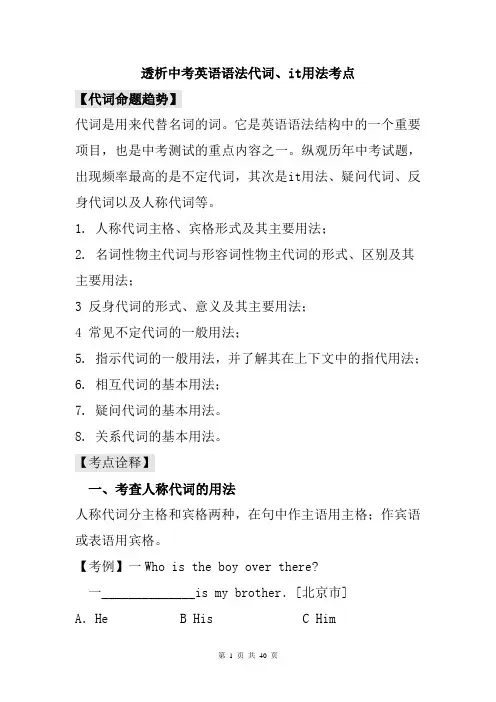
透析中考英语语法代词、it用法考点【代词命题趋势】代词是用来代替名词的词。
它是英语语法结构中的一个重要项目,也是中考测试的重点内容之一。
纵观历年中考试题,出现频率最高的是不定代词,其次是it用法、疑问代词、反身代词以及人称代词等。
1. 人称代词主格、宾格形式及其主要用法;2. 名词性物主代词与形容词性物主代词的形式、区别及其主要用法;3 反身代词的形式、意义及其主要用法;4 常见不定代词的一般用法;5. 指示代词的一般用法,并了解其在上下文中的指代用法;6. 相互代词的基本用法;7. 疑问代词的基本用法。
8. 关系代词的基本用法。
【考点诠释】一、考查人称代词的用法人称代词分主格和宾格两种,在句中作主语用主格;作宾语或表语用宾格。
【考例】一Who is the boy over there?一______________is my brother.[北京市]A.He B His C HimD.Himself[答案]A。
[解析]主格作主语(放在谓语动词前),宾格作宾语,放在介词、动词后面。
依据句意:“他是我兄弟”看出,——为主语,主语用主格,故选A。
——Look! What's the postman giving Mrs Chen?一He's giving ____a letter.[沈阳市]A itB him C.meD.her[答案]D。
[解析]指代上句中的Mrs Chen应用her,作give 的宾语。
二、考查物主代词的用法1、名词性物主代词和形容词性物主代词。
形容词性物主代词只能做定语,不能单独担任句子的某一成分;而名词性物主代词可单独做主语、宾语或表语,它相当于形容词性物主代词加名词。
【考例】 ---My pen is lost.---Don't worry "about it. You can use__________.[吉林省]A. myB. mineC. meD. myself[答案]B。
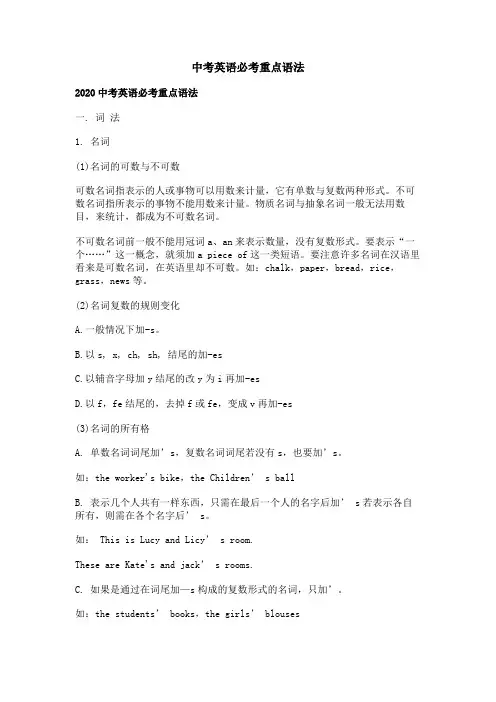
中考英语必考重点语法2020中考英语必考重点语法一. 词法1. 名词(1)名词的可数与不可数可数名词指表示的人或事物可以用数来计量,它有单数与复数两种形式。
不可数名词指所表示的事物不能用数来计量。
物质名词与抽象名词一般无法用数目,来统计,都成为不可数名词。
不可数名词前一般不能用冠词a、an来表示数量,没有复数形式。
要表示“一个……”这一概念,就须加a piece of这一类短语。
要注意许多名词在汉语里看来是可数名词,在英语里却不可数。
如:chalk,paper,bread,rice,grass,news等。
(2)名词复数的规则变化A.一般情况下加-s。
B.以s, x, ch, sh, 结尾的加-esC.以辅音字母加y结尾的改y为i再加-esD.以f,fe结尾的,去掉f或fe,变成v再加-es(3)名词的所有格A. 单数名词词尾加’s,复数名词词尾若没有s,也要加’s。
如:the worker's bike,the Children’ s ballB. 表示几个人共有一样东西,只需在最后一个人的名字后加’ s若表示各自所有,则需在各个名字后’ s。
如:This is Lucy and Licy’ s room.These are Kate's and jack’ s rooms.C. 如果是通过在词尾加—s构成的复数形式的名词,只加’。
如:the students’ books,the girls’ blouses(另外:名词+of+名词名词是有生命的,我们就用’s结构来表示所有关系。
如果名词所表示的事物是无生命的,我们就要用名词+of+名词的结构来表示所有关系。
)2. 代词人称代词,物主代词,反身代词,指示代词,不定代词(1)人称代词第一人称单数I me my mine myself复数 we us our ours ourselves第二人称单数 you you your yours yourself复数 you you your yours yourselves第三人称单数 he him his his himselfshe her her hers herselfit it its its itself复数 they them their theirs themselves(2)物主代词物主代词的用法:形容词性物主代词后面一定要跟上一个名词;名词性物主代词可作主语、表语、宾语。
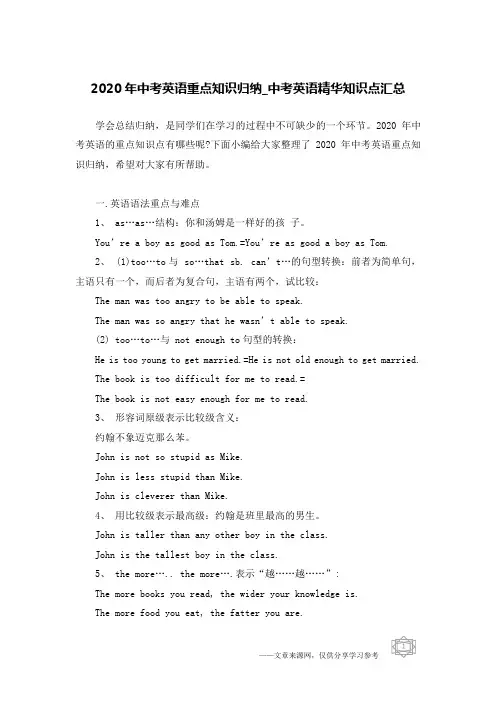
2020年中考英语重点知识归纳_中考英语精华知识点汇总学会总结归纳,是同学们在学习的过程中不可缺少的一个环节。
2020年中考英语的重点知识点有哪些呢?下面小编给大家整理了2020年中考英语重点知识归纳,希望对大家有所帮助。
一.英语语法重点与难点1、 as…as…结构:你和汤姆是一样好的孩子。
You’re a boy as good as Tom.=You’re as good a boy as Tom.2、 (1)too…to与 so…that sb. can’t…的句型转换:前者为简单句,主语只有一个,而后者为复合句,主语有两个,试比较:The man was too angry to be able to speak.The man was so angry that he wasn’t able to speak.(2) too…to…与 not enough to句型的转换:He is too young to get married.=He is not old enough to get married.The book is too difficult for me to read.=The book is not easy enough for me to read.3、形容词原级表示比较级含义:约翰不象迈克那么苯。
John is not so stupid as Mike.John is less stupid than Mike.John is cleverer than Mike.4、用比较级表示最高级:约翰是班里最高的男生。
John is taller than any other boy in the class.John is the tallest boy in the class.5、 the more….. the more….表示“越……越……”:The more books you read, the wider your knowledge is.The more food you eat, the fatter you are.6、 more and more….表示“越来……越……”:More and more students realized the importance of a foreign language.Our country is getting stronger and stronger.二.中考考点—词组1. after, in这两个介词都可以表示“……(时间)以后”的意思after 以过去为起点,表示过去一段时间之后,常用于过去时态的句子中?如:She went after three days. 她是三天以后走的in 以现在为起点,表将来一段时间以后,常用于将来时态的句子中如:She will go in three days. 她三天以后要走2. how long, how often, how soonhow long指多长时间,主要用来对一段时间(如three days, four weeks 等)提问?如:How long ago was it? 这是多久前的事了?how often指每隔多久,主要用来对频率副词或状语(如once a week等)提问?如:—How often does he come here? —Once a month. 他(每隔)多久来一次?每月一次。
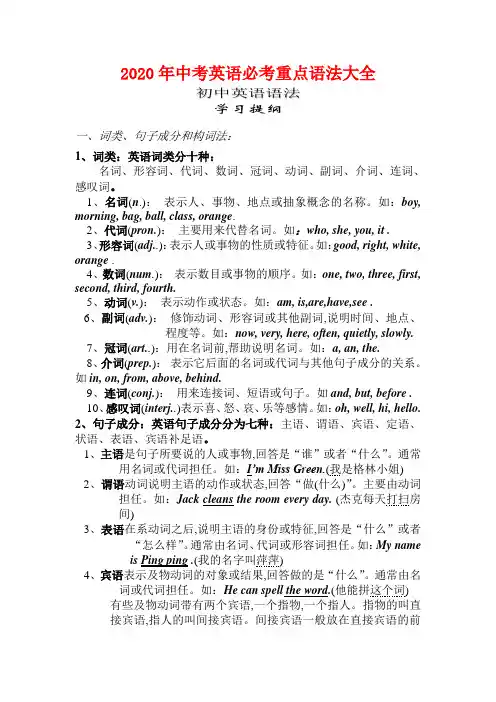
2020年中考英语必考重点语法大全初中英语语法学习提纲一、词类、句子成分和构词法:1、词类:英语词类分十种:名词、形容词、代词、数词、冠词、动词、副词、介词、连词、感叹词。
1、名词(n.):表示人、事物、地点或抽象概念的名称。
如:boy, morning, bag, ball, class, orange.2、代词(pron.):主要用来代替名词。
如:who, she, you, it .3、形容词(adj..):表示人或事物的性质或特征。
如:good, right, white, orange .4、数词(num.):表示数目或事物的顺序。
如:one, two, three, first, second, third, fourth.5、动词(v.):表示动作或状态。
如:am, is,are,have,see .6、副词(adv.):修饰动词、形容词或其他副词,说明时间、地点、程度等。
如:now, very, here, often, quietly, slowly.7、冠词(art..):用在名词前,帮助说明名词。
如:a, an, the.8、介词(prep.):表示它后面的名词或代词与其他句子成分的关系。
如in, on, from, above, behind.9、连词(conj.):用来连接词、短语或句子。
如and, but, before .10、感叹词(interj..)表示喜、怒、哀、乐等感情。
如:oh, well, hi, hello.2、句子成分:英语句子成分分为七种:主语、谓语、宾语、定语、状语、表语、宾语补足语。
1、主语是句子所要说的人或事物,回答是“谁”或者“什么”。
通常用名词或代词担任。
如:I’m Miss Green.(我是格林小姐) 2、谓语动词说明主语的动作或状态,回答“做(什么)”。
主要由动词担任。
如:Jack cleans the room every day. (杰克每天打扫房间)3、表语在系动词之后,说明主语的身份或特征,回答是“什么”或者“怎么样”。
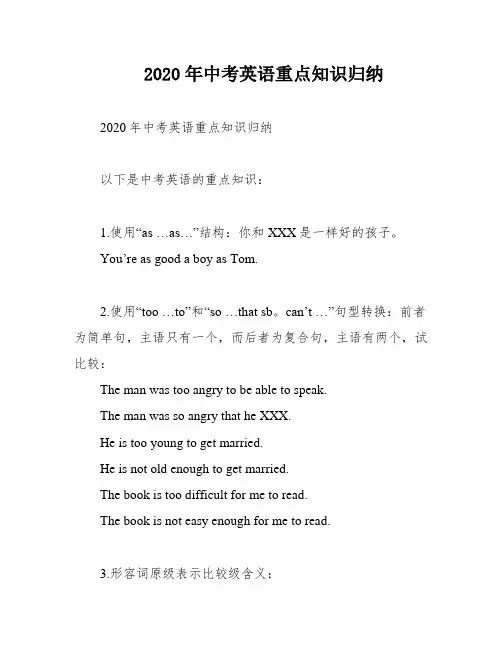
2020年中考英语重点知识归纳2020年中考英语重点知识归纳以下是中考英语的重点知识:1.使用“as …as…”结构:你和XXX是一样好的孩子。
You’re as good a boy as Tom.2.使用“too …to”和“so …that sb。
can’t …”句型转换:前者为简单句,主语只有一个,而后者为复合句,主语有两个,试比较:The man was too angry to be able to speak.The man was so angry that he XXX.He is too young to get married.He is not old enough to get married.The book is too difficult for me to read.The book is not easy enough for me to read.3.形容词原级表示比较级含义:John is not as stupid as XXX.John is less stupid than XXX.XXX cleverer than XXX.4.使用比较级表示最高级:John is taller than any other boy in the class.John is the tallest boy in the class.5.使用“the more … the more …”表示“越……越……”:The more books you read。
the wider your knowledge is.The more food you eat。
the fatter you are.More and more students are realizing the importance of a foreign language.XXX.中考考点—词组:1.“after”和“in”这两个介词都可以表示“……(时间)以后”的意思。

2020中考英语语法、词汇考点汇总一.语法1.情态动词(1).考查情态动词表示“推测”的用法[考点] 表示肯定推测的情态动词有:must“一定;准是”,may“也许;可能”,might“或许”;表示否定推测的情态动词有:can't“不可能”,couldn't“不会”,may not“也许不”,might not“或许不”;can表示推测时不用于肯定句,may表示推测时不用于疑问句。
(2).考查情态动词引起的一般疑问句的答语[考点] 回答must时,肯定答语用must,否定答语用needn't或don't have to。
回答need时,肯定答语用must,否定答语用needn't。
回答may时,肯定答语用may,否定答语用mustn't 或can't。
(3).考查情态动词的意义[考点] must “必须”;have to“不得不”;need “必须;需要”;can(could)“能;可能”;may (might) “可以;可能”;shall,will (would)“将;会;愿意;要”;should“应当”。
“had better (not) + 动词原形”表示建议;have to / has to /had to的否定,疑问形式要借助于助动词do /does /did。
2. There be句子结构There be是一个“存在”句型,表示“有”的意思肯定句的形式为:There be + 名词(单数或复数)+地点状语或时间状语。
be动词单复数的确定,看be后边第一个名词,当所接主语为单数或不可数名词时,be动词形式为is;当所接主语为复数名词时,be动词为are;当be动词后接两个以上主语时,be动词与最临近主语保持数上的一致。
意思为“某地有某人或某物”。
如:There is an eraser and two pens>There are two pens and an eraser(a)there be的否定句,即在be的后面加上not。
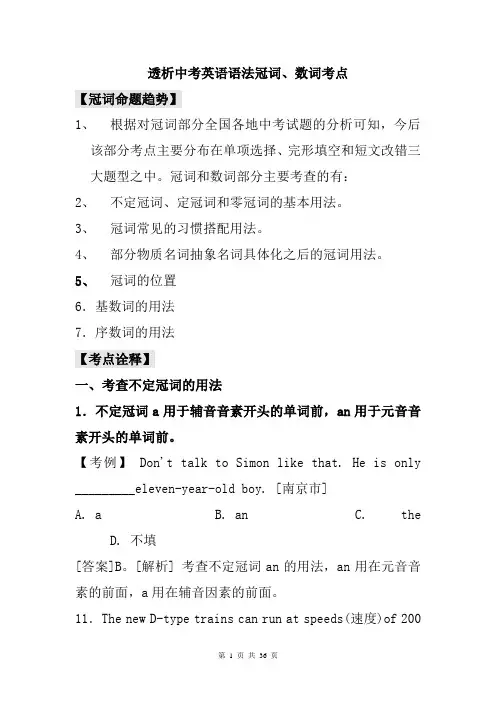
透析中考英语语法冠词、数词考点【冠词命题趋势】1、根据对冠词部分全国各地中考试题的分析可知,今后该部分考点主要分布在单项选择、完形填空和短文改错三大题型之中。
冠词和数词部分主要考查的有:2、不定冠词、定冠词和零冠词的基本用法。
3、冠词常见的习惯搭配用法。
4、部分物质名词抽象名词具体化之后的冠词用法。
5、冠词的位置6.基数词的用法7.序数词的用法【考点诠释】一、考查不定冠词的用法1.不定冠词a用于辅音音素开头的单词前,an用于元音音素开头的单词前。
【考例】 Don't talk to Simon like that. He is only_________eleven-year-old boy. [南京市]A. aB. anC. theD. 不填[答案]B。
[解析] 考查不定冠词an的用法,an用在元音音素的前面,a用在辅音因素的前面。
11.The new D-type trains can run at speeds(速度)of 200to 250 kilometres ______hour. The trip from Shanghai to Beijing only takes 10 hours now. [哈尔滨市]A. aB. anC. the [答案]B。
[解析] 考查冠词用法。
hour第一个音素为元音音素,故前不能加a。
12.It's _____________easy job. I think you can do it by yourself. [吉林省]A. aB. anC. theD. / [答案]B。
[解析] 考查a,an和the:a/an表泛指,a用于辅音音素前,an用于元音音素前,the表特指。
job是可数名词,从上下句意看,“这是一项简单的工作,……”,可排除C、D,easy以元音音素开头,故选B。
2.不定冠词a/an用于单数可数名词前,表泛指,说明事物的种类或类属。
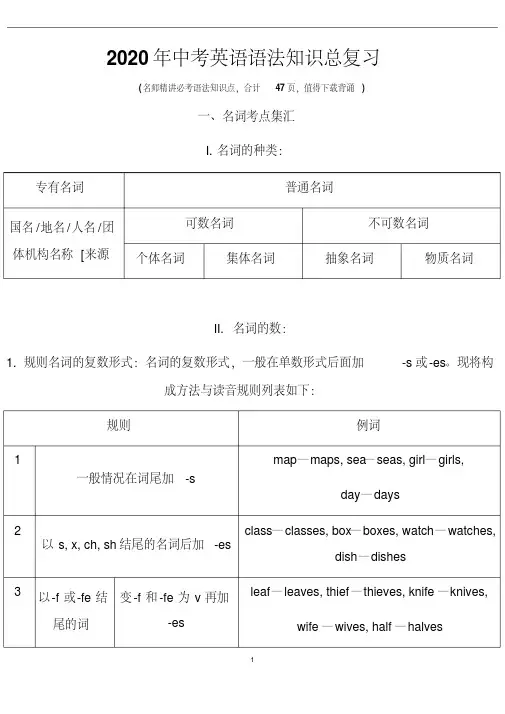
2020年中考英语语法知识总复习(名师精讲必考语法知识点,合计47页,值得下载背诵)一、名词考点集汇I.名词的种类:专有名词普通名词国名/地名/人名/团体机构名称[来源可数名词不可数名词个体名词集体名词抽象名词物质名词II. 名词的数:1. 规则名词的复数形式:名词的复数形式,一般在单数形式后面加-s或-es。
现将构成方法与读音规则列表如下:规则例词1一般情况在词尾加-smap—maps, sea—seas, girl—girls,day—days2以s, x, ch, sh结尾的名词后加-es class—classes, box—boxes, watch—watches,dish—dishes3以-f或-fe结尾的词变-f和-fe为v再加-esleaf—leaves, thief—thieves, knife—knives,wife—wives, half—halves加-s chief—chiefs, proof—proofs, roof—roofs4以辅音字母加y结尾的名词, 变y为i加-es party—parties, family—families, story—stories, city—cities5以元音字母加y结尾的名词, 或专有名词以y结尾的加-s toy—toys, boy—boys, day—days, ray—rays,Henry—Henrys6以辅音字母加-o结尾的名词一般加-esNegro—Negroes, hero—heroes,potato—potatoes, tomato—tomatoes不少外来词加-spiano—pianos, photo—photos, auto—autos,kilo—kilos, solo—solos 两者皆可zero—zeros/zeroes, volcano—volcanoes /volcanos7以元音字母加-o结尾的名词加-sradio—radios, bamboo—bamboos,zoo—zoos8以-th结尾的名词加-struth—truths, mouth—mouths,month—months, path—paths 2. 不规则名词复数:英语里有些名词的复数形式是不规则的,现归纳如下:规则例词1改变名词中的元音字母或其他形式man—men, woman—women, foot—feet, goose—geese, mouse—mice2单复数相同sheep, deer, means, works, fish, yuan, jin, 3只有复数形式trousers, clothes, thanks, goods, glasses 4一些集体名词总是用作复数people, police5部分集体名词既可以作单数(整体)也可以作复数(成员)class, family, crowd, couple, group, government, population, team, public, party6复数形式表示特别含义customs (海关), times (时代), spirits (情绪), drinks (饮料), sands (沙滩), papers (文件报纸), looks (外表), brains (头脑智力), greens(青菜)7表示“某国人”加-sAmericans, Australians, Germans, Greeks,Swedes, Europeans单复数同形Swiss, Portuguese, Chinese, Japanese 以-man或-woman结尾的改为-men,-womenEnglish men, Frenchwomen8合成名词将主体名词变为复数sons-in-law, lookers-on, passers-by,story-tellers, boy friends无主体名词时将最后一部分变为复数grown-ups, housewives, stopwatches 将两部分变为复数women singers, men servantsIII. 名词的所有格:名词在句中表示所有关系的语法形式叫做名词所有格。
2020 中考英语高频考点盘点一.英法重点与点1、 as⋯as⋯构:你和姆是一好的孩子。
You’re a boy as good as Tom.=You’re as good a boy as Tom.2、 (1)too ⋯to 与 so⋯that sb. can’t ⋯的句型:前者句,主只有一个,而后者复合句,主有两个,比:The man was too angry to be able to speak.The man was so angry that he wasn’t able to speak.(2) too⋯to ⋯与 not enough to 句型的:He is too young to get married.=He is not old enough to get married.The book is too difficult for me to read.=The book is not easy enough for me to read.3、形容原表示比含:翰不象克那么苯。
John is not so stupid as Mike.John is less stupid than Mike.John is cleverer than Mike.4、用比表示最高:翰是班里最高的男生。
John is taller than any other boy in the class.John is the tallest boy in the class.5、 the more⋯ .. the more⋯.表示“越⋯⋯越⋯⋯” : The morebooks you read, the wider your knowledge is. Themore food you eat, the fatter you are.6、 more and more⋯.表示“越来⋯⋯越⋯⋯”:More and more students realized the importance of a foreign language.Our country is getting stronger and stronger.二.中考考点—1.after, in 两个介都可以表示“⋯⋯ ()以后”的意思after 以去起点 ,表示去一段之后 ,常用于去的句子中?如:She went after three days. 她是三天以后走的in 以现在为起点 ,表将来一段时间以后 ,常用于将来时态的句子中如:She will go in three days. 她三天以后要走2. how long, how often, how soonhow long 指多长时间 ,主要用来对一段时间 (如 three days, four weeks 等 )提问 ?如:How long ago was it? 这是多久前的事了 ?how often 指每隔多久 ,主要用来对频率副词或状语(如 once a week 等)提问 ?如:—How often does he come here? —Once a month. 他(每隔 )多久来一次 ?每月一次。
2020年中考英语语法知识复习大全【名师精讲语法知识点,值得下载背诵】一、疑问句型.........................................................(2-38)二、假设法句型.....................................................(39-72)三、比较句型........................................................(73-134)四、含不定词句型..............................................(135-167)五、含分词之句型..............................................(168-219)六、含助动词之句型..........................................(220-247)七、含代名词之句型......................................(248-266)八、含关系词之句型.................................... ..(267-296)九、否定句型..........................................(297-411)一、疑问句型1.What is this?结构︰问句:What+be 动词+this(that…)?答句:This(that…)+be 动词+a book(pen…)。
说明︰此句型意为“这(那)是什么?这(那)是书(钢笔…)”。
what(什么)叫做“疑问词”,用于询问“事物”,通常放在句首,后接be <动词>,再接<主词>,第一个字母w要大写,句尾要加问号(?),位置不可排错。
What is this? This is a chair. 这是什么?这是一张椅子。
八大时态一般现在时:常与always,often,sometimes, every day连用,表示习惯或经常反复发生的动作或存在的状态。
提醒你当第三人称单数做主语时,别忘了动词的变化。
注意:象"地球大,月亮小"等客观真理、事实一定用一般现在时。
现在进行时:要注意其构成:由be+动词+ing,表示说话时正在进行的动作。
如:We're studying now. 我们现在正在学习。
一般过去时:表示过去某个时间发生的动作或存在的状态,常与yesterday,last year,in 1949,two years ago,等表示过去时间的状语连用。
注意:We often went to dance last summer.有的同学一见到often就想到用一般现在时,其实因为后面有表示过去时间的last summer,所以要用过去式,千万别误用了,切记,切记。
过去进行时:显然过去进行时表示过去某一时刻正在做什么,常和特定的时间状语如at that time,at six yesterday,at that moment,when he came in等连用。
如:When he knocked at the door,his mother was cooking.一般将来时:表示将要发生的动作或存在的状态,常与表示将来时间状语如next year,tomorrow等连用。
注意:在Will you ....?问句中,回答必须是Yes,I will.或No,I won't而不能用Yes,I shall. No, I shan't.来回答过去将来时:过去将来时不可以单独使用,它一般在宾语从句中作间接引语,表示从过去某一时间看来将要发生的动作或存在的状态。
如:They told me that they would go to work in Guangdong.现在完成时:顾名思义,现在完成时表示的是已经完成的动作,但动作造成的影响还在,常被just,already,yet 等副词修饰。
中考英语语法知识点总结归纳一、名词。
1. 名词的数。
- 可数名词:有单复数形式。
- 规则变化:- 一般在词尾加 -s,如book - books。
- 以s, x, ch, sh结尾的名词加 -es,如box - boxes,watch - watches。
- 以辅音字母 + y结尾的名词,变y为i再加 -es,如baby - babies;但以元音字母 + y结尾的名词直接加 -s,如day - days。
- 以f或fe结尾的名词,变f或fe为v再加 -es,如knife - knives,leaf - leaves(但也有一些直接加 -s的,如roof - roofs)。
- 不规则变化:- 单复数同形,如fish(表示鱼的种类时可加 -es),sheep,deer等。
- 改变元音字母,如man - men,woman - women,foot - feet,tooth - teeth 等。
- 表示“某国人”的复数:- 中日不变,如Chinese - Chinese,Japanese - Japanese。
- 英法变,如Englishman - Englishmen,Frenchman - Frenchmen。
- 其他加 -s,如American - Americans。
- 不可数名词:没有复数形式,不能直接用数词修饰,如water,milk,bread 等。
如果要表示数量,可以用“a piece of/a glass of/a cup of +不可数名词”等结构。
2. 名词所有格。
- 有生命的名词所有格:- 一般在名词后加's,如Tom's book。
- 以s结尾的复数名词只加',如the students' classroom。
- 表示两者或多者共有时,只在最后一个名词后加's,如Lucy and Lily's room (表示两人共有的房间);表示各自拥有时,每个名词后都加's,如Lucy's and Lily's rooms(表示两人各自的房间)。
2016年最新中考英语语法考点汇总(最全版)专题一名词名词就是中考考查得重点。
考查内容主要为:1、名词单、复数得变化规律及其用法;2、不可数名词量得表达法;3、名词所有格得变化及其用法;4、名词作主语得一致问题;5、常用专有名词得表示法;6、具体语境中名词得词义与一些常用易混淆名词得区别。
Ⅰ、名词得定义名词就是表示人、事物、现象与其她抽象概念得名称得词。
名词可分为专有名词与普通名词。
专有名词就是具体得人与事物等特有名称。
专有名词得第一个字母要大写,人名、地名、公共节日及月份、周日得名称等等都就是属于专有名词。
(见资料)如:Yao Ming 姚明; China 中国;Christmas 圣诞节等。
Ⅱ、可数名词与不可数名词普通名词按照其所表示得事物得性质分为可数名词与不可数名词。
1.可数名词可数名词有单数与复数两种形式。
如:an apple; two apples 。
★注意: a 用于以辅音音素( 指音标) 开头得单数名词前;an 用于以元音音素( 指音标) 开头得单数名词前。
如:a book/b uk/, a useful/ju:sful/ book ,an apple/’aepl/ ,a red apple , an hour/’aua/2.不可数名词: 不可数名词包括物质名词与抽象名词,没有复数形式。
(1)物质名词。
如: water; rice; tea; milk; food; fruit; meat; fish(鱼肉); chicken(鸡肉); beef; mutton; orange(橙汁);sugar; salt; paper(纸); porridge; bread; sand; juice等。
这类不可数名词需要计量时要在名词前加表示量得词。
如:a cup of tea; two bags of rice; three bottles of water等。
(2)抽象名词。
如: news; music; time(时间); information等。
(3)不可数名词不能与数词或不定冠词连用。
(4)注意有些名词既可做可数名词也可做不可数名词。
如:fish; time; glass; orange; room; noise; chicken等。
但使用时一定要区分它们表达得不同意义。
Ⅲ、名词得数(1)元音或词尾发生变化如:man→men; woman→women; Frenchman→Frenchmen; tooth→teeth; foot→feet; child→children(2)单复数形式相同如:sheep→sheep; fish→fish; Chinese→Chinese; Japanese→Japanese; yuan→yuan(3)形式为单数意思为复数如:people,police(集合名词)(4)形式为复数意思为单数如:news, maths, physics, the United States等。
(5)只用复数形式如:pants, shorts, clothes,glasses(眼镜)等。
3、不可数名词得量得表示:(不能直接用数字;不能直接加a。
an;无复数形式)(1)表不定数量时,一般用much,(a)little, a lot of/lots of, some, any等词修饰。
(2)表确定数量时,一般用“数词+量词+of+不可数名词。
如:a piece of paper, a piece of news, a bag of rice, two glasses of milk, four bottles of waterⅣ、名词得所有格:1、有生命得名词所有格(1) 单数名词后加’s 。
如:my brother’s book(2) 不以s 结尾得复数名词后加’s 。
如:the children’s football(3) 以s 结尾得复数名词后加’ 。
如:the boys’ game(4) 以s 结尾得专有名词后直接加’ 。
如:Dickens’ novels(5)某物为两个名词共有时,在第二个名词后加’s : 如:Tom and David’s room、(6) 表示两个名词各自拥有得东西,在两个名词后都加’s: 如:Tom’s and David’s rooms、2、无生命得事物得名词所有格(of所有格)(1)of+名词。
如:a photo of my family, the door of the classroom注意:“of+名词’s/名词性物主代词” 构成双重所有格如:a friend of mine, a friend of Jim’s。
(2) 表示时间或距离,国家,城市得方法。
也可用’s来构成所有格▲如:ten minutes’ drive十分钟车程;a month’s holiday一个月得假期。
China’s capital(3)表称呼、职业等名词得所有格可以表示人得住所或工作场所。
所有格后面得名词一般被省去。
如:at his brother’s; at the doctor’s; at the barker’s; at Mr Read’s(4)用所有格表示节日得方法: 如:Teachers’ Day; Children’s Day、(除了父亲节与母亲节其她节日我们都用名词复数得所有格表示。
)如:Mother’s Day; Father’s Day、▲(5)、由some、any、no、every与one、body 结合得复合不定代词something 、anything 等与else 连用时,所有格应加在else得后面。
This is _________________(somebody else ) pencil 、四、名词作句子成分:★1、名词作主语1)、表示时间、金钱、距离作主语时,谓语动词用单数。
Two hours _______(be) enough for us to get there 、2)、量词短语“数字+量词+ of +…”作主语时,谓语动词应与量词保持一致。
A pair of shoes _______(be) under the bed 、Two pieces of paper _______(be) on the desk 、3)、名词+介词(with、except 、along with …、)+名词作主语时,谓语动词应与前面得名词保持一致。
The teacher with the students _________(be) planting trees on the hill 、4)、短语“neither…nor…、either…or…、not only…but also …”连接主语时,谓语动词实行就近原则。
Neither he nor I ______ (be) a Frenchman 、★2、名词作定语1)、名词作定语时,一般用单数形式。
变复数时,名词中得中心词变为复数形式。
如:a banana tree→banana trees; a shoe factory→shoe factories There is a shoe factory near the school 、2)、名词作定语时,个别情况用复数形式。
(sport )The sports meeting will be held next week 、3)、man、woman 作定语表示性别时,man、woman随后面得名词单复数而变。
QQ378459309制作one man teacher two women teachers专题二冠词中考对冠词得考查主要为:不定冠词a与an得用法,定冠词the得用法,零冠词得用法,习惯用语中冠词得位置及使用。
Ⅰ、冠词得定义冠词就是虚词。
通常放在名词之前,用来说明名词所表示得人或事物。
冠词分为不定冠词(a与an)与定冠词(the)两类。
Ⅱ、冠词得用法1.不定冠词a, an得用法(1)泛指某人或某物,但不具体说明何人或何物。
A girl is waiting for you、(2)不定冠词a 用在以辅音音素开头得单数可数名词前;a useful book; a desk;不定冠词an 用在以元音音素开头得单数可数名词前。
如: an old man; an actor; an “m”。
(3)第一次提到某人或某物而非特指时。
如:There is a book on the desk, but the book isn’t mine、(4)表示人或事物得某一类。
如:An elephant is bigger than a tiger、(5)用于表时间、速度、价格等意义得名词之前,有“每一”得意思,相当every 如: three times a week、(6) 表示数量,有“一”得意思,但数得概念没有one强烈。
I have a puter、(7)用在序数词前,表示“又一,再一”I have three books、I want to buy a fourth one、(8)可视为一个整体得两个名词前eg: a knife and fork 一副刀叉(9)用在某些固定词组中:如:have a good time; have a swim ,have a cold , half an hour ,a lot(of), after a while , in a hurry , for a long time, a few ,a little ,at a time ,2.定冠词the得用法(1)用来特指某人或某物,双方都知道得人或物得名词前如:Open the door, please、(2)用于上文提到得某人或某物。
There is a kite on the wall、The kite is new、(3)表示世界上独一无二得事物得名词前如:the sun; the moon; the earth; the sky(4)用在序数词或形容词最高级前,如:March is the third month of a year、He is the cleverest boy in his class、(5)用在某些形容词前, 表示一类人。
如:the rich; the poor; the young; the old等。
(6)用在西洋乐器名词前。
如:play the violin(7)用在表示方位得名词前。
如:in the east/north/west/south(8)用在表示山脉、海洋、江河、湖泊、群岛、建筑物、名胜古迹等专有名词前或用在由普通名词构成得专有名词前。
如:the Yellow River; the Great Wall; the West Lake; the White House等(9)用在姓氏复数形式前,表示“全家人”或“夫妻俩”。